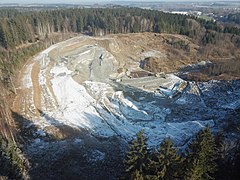| Hammerschmiede Clay Pit | |
|---|---|
| Stratigraphic range: Serravallian-Tortonian | |
 Image of the clay pit | |
| Type | Fossil site |
| Unit of | Upper Freshwater Molasse |
| Thickness | 25.7 m |
| Lithology | |
| Primary | Silts, sandstone and claystone |
| Location | |
| Coordinates | 47°55′38″N 10°35′28″E / 47.92722°N 10.59111°E |
| Region | |
| Country | |
The Hammerschmiede clay pit (German: Tongrube Hammerschmiede) is a fossil bearing locality in Pforzen, Bavaria, Germany most well known for the discovery of Danuvius guggenmosi, the potentially earliest known bipedal ape. With an age of 11.66-11.42 Ma the site dates to the transition between the Middle and Late Miocene epoch, providing an important window into the faunal changes taking place during this time. This correlates to the time just after the Serravallian-Tortonian boundary, and the MN zones 7/8. It is one of the most well-known Miocene sites, with over 15,000 individual fossils and 117 species having been discovered as of 2020. It has been called "the most important German paleontological discovery of the last decades".[1]

